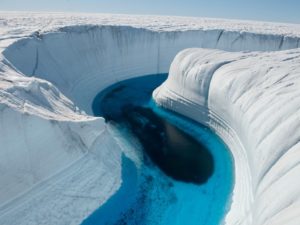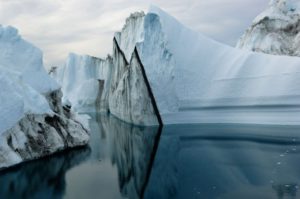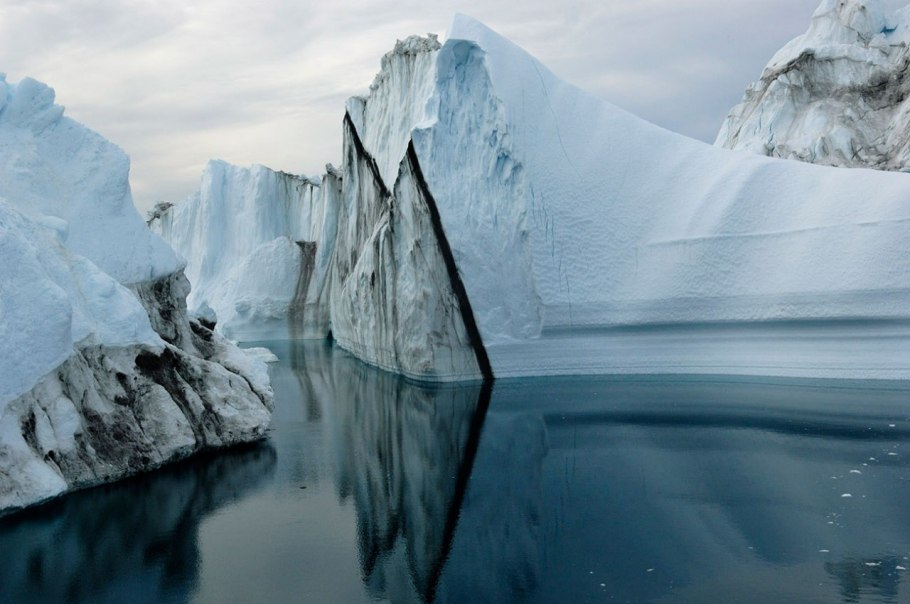In his new film on the disappearance of Arctic glaciers, “Chasing Ice,” author, award-winning photographer and reformed climate-change denier James Balog used time-lapse photography to capture global warming in progress.
httpvh://youtu.be/eIZTMVNBjc4
Trailer for the documentary Chasing Ice.
Capturing The Horror Of Climate Change in the Arctic
In the spring of 2005, James Balog headed to the Arctic on a tricky assignment for National Geographic: to capture images to help tell the story of the Earth’s changing climate. With the understanding that global warming is an abstract process typically associated with measurements and statistics, Balog sought to capitalize on his experience as a mountaineer to bring images of its most obvious effects—the melting of Arctic ice—to the public. But that first trip north opened his eyes to a story of epic proportions: the melting of the Arctic glaciers is an early warning of massive changes across the globe.


Tim Appenzeller, “National Geographic”: From the high mountains to the vast polar ice sheets, the world is losing its ice faster than anyone thought possible. Most glaciers in the Alps could be gone by the end of the century, Glacier National Park’s (Montana) namesake ice by 2030. The small glaciers sprinkled through the Andes and Himalaya have a few more decades at best. And the prognosis for the massive ice sheets covering Greenland and Antarctica? No one knows, if only because the turn for the worse has been so sudden.
Dr. James Hansen, “The Guardian UK”: No credible scientist disputes that we have warmed our climate by almost 1.5C over land areas in the past century, most of that in the past 30 years. We can fix this. The answer is a price on carbon. We must make the price of fossil fuels honest, reflecting their cost to society including the economic devastation wrought by storms like Sandy, the toll on farmland and ecosystems, as well as priceless human lives.


Doyle Rice, “Sci-Tech Today”: This year’s average national US temperature of 57.1 degrees is 3.3 degrees above average, making it a near certainty that 2012 will go down as the warmest year in history. The heat has kept much of the nation drier than average, helping contribute to the worst drought since the 1950s and the second-worst wildfire season on record in acreage burned.
Within months of that first trip to Iceland, they realized time-lapse photography could tell the story. So the team placed cameras set to snap pictures every 10 minutes at key locations thoughout the Arctic the photographer on a series of expeditions over several years, called The Extreme Ice Survey.
After a disappointing climate summit in Doha, it becomes clear that unless we act now to reduce the burning of fossil fuels, massive destructive changes to the Earth’s climate will continue with greater frequency in harsher superstorms, wildfires, droughts, etc. Amory Lovins from the Rocky Mountain Institute sees a future ahead in renewable energy:
U.S. photovoltaics have doubled each of the last two years. World [photovoltaic] growth last year — a difficult year for many industries — was 70 percent. And 68 percent of Europe’s new capacity last year was solar and wind. Wind, for example, is generally competitive without subsidy, even though the global wind industry will of course shift its projects in a given year to wherever they get the most subsidy, as you would expect. But even without subsidy they have a very strong business case.
For further solutions, look to “Citizens Climate Lobby” with their recent press release:
Economists on both ends of the political spectrum – from Jeffrey Sachs and Robert Shapiro on the [center] left to Art Laffer and Greg Mankiw on the right – contend that the most effective approach to deal with climate change is a revenue-neutral fee or tax on carbon-based fuels that returns the proceeds to the public, either through direct payment or reductions in other taxes. The concept, they say, is rather simple: Tax the thing we want less of – carbon pollution – and reduce taxes on the thing we want more of – income.
Placing a direct fee on carbon – increasing the costs of coal, oil and gas – will send a price signal to the marketplace that makes clean energy a more attractive investment. Billions of dollars in private sector money would shift away from fossil fuels and toward technologies like wind, solar, geothermal, water and other alternatives. It would also provide the incentive for consumers and businesses to improve energy efficiency and make choices, like hybrid or electric vehicles, that have a lower carbon footprint.
The fate of larger portions of our human civilization hang in the imbalance. We have no time to lose.










Pingback: Jan Freed: Mother Nature's Climate Wrath Will Be Costly | WilderUtopia.com
Pingback: Addressing Climate Change in a World of Denialism | WilderUtopia.com
Pingback: Robert Haw: Overcoming Climate Disaster with a Carbon Tax | WilderUtopia.com
Pingback: Climate Disruption: Arctic Death Spiral Underway | WilderUtopia.com
Pingback: Extreme Ice Melt in Arctic Unprecedented | WilderUtopia.com